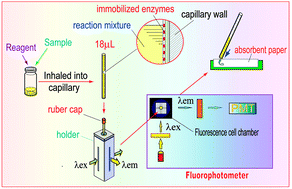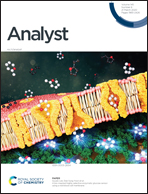A novel immobilization fluorescence capillary analysis method and its applications
Abstract
Fluorescence capillary analysis (FCA) realizes trace-level analysis of micro-volume samples; it is easy to operate, extremely low in analytical cost and can significantly lessen environmental pollution from analytical chemistry waste. FCA has the characteristics of green analytical chemistry and has been applied in clinical, biochemical, pharmaceutical, food safety and other fields. FCA basically involves a micro-volume glass capillary, a capillary holder and an ordinary fluorescence detector. The capillary is not only a container for chemical reaction and detection but also functions as a carrier to immobilize enzymes, gene probes or reagents; it can be used repeatedly or can be disposable. In analysis, the capillary which is modified with functional reagents sucks in a measured liquid for the reaction and is then inserted into the holder within the fluorescent detector for measurement. The immobilized FCA method has been successfully used in the determination of reduced coenzyme I, ethanol in liqueur, lactic acid in dairy products, pyruvic acid and glucose in serum, trace-level sulfated bile acid in urine, the ratio of pyruvic/lactic acid in serum, and pyruvic acid in cells as well as in DNA end-labeling and dyeing methods. Further, FCA can also be extended to capillary arrays to complete multipurpose simultaneous determinations and can be combined with mobile phones as fluorescence detectors for use in mobile health analytical technology. FCA will produce considerable social benefits in medicine, pharmacy, fermentation of food, environmental protection and other fields. Therefore, the relevant contents are presented in this tutorial review.



 Please wait while we load your content...
Please wait while we load your content...